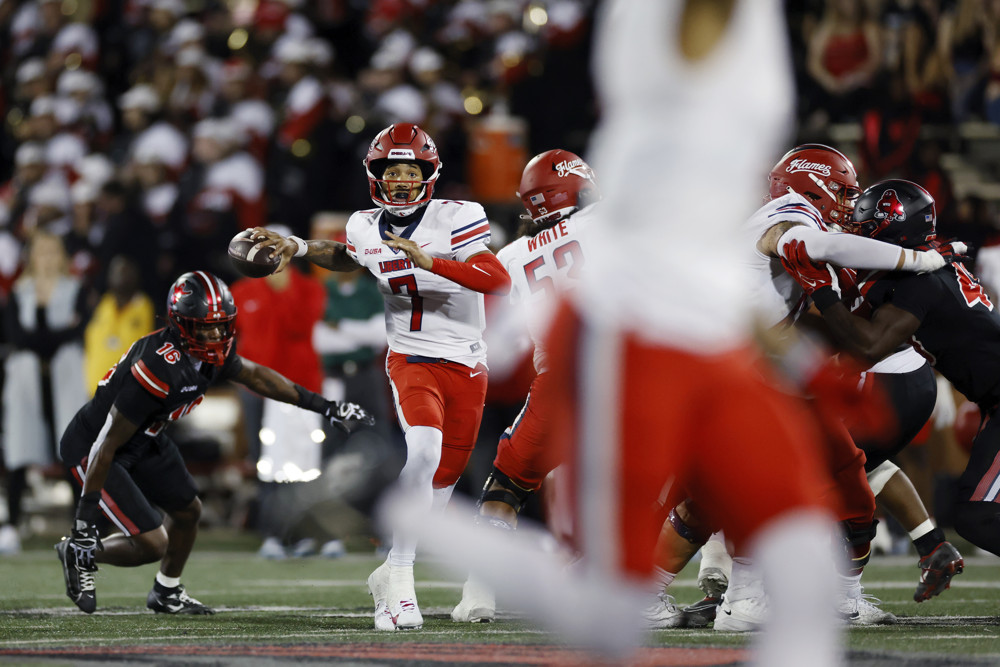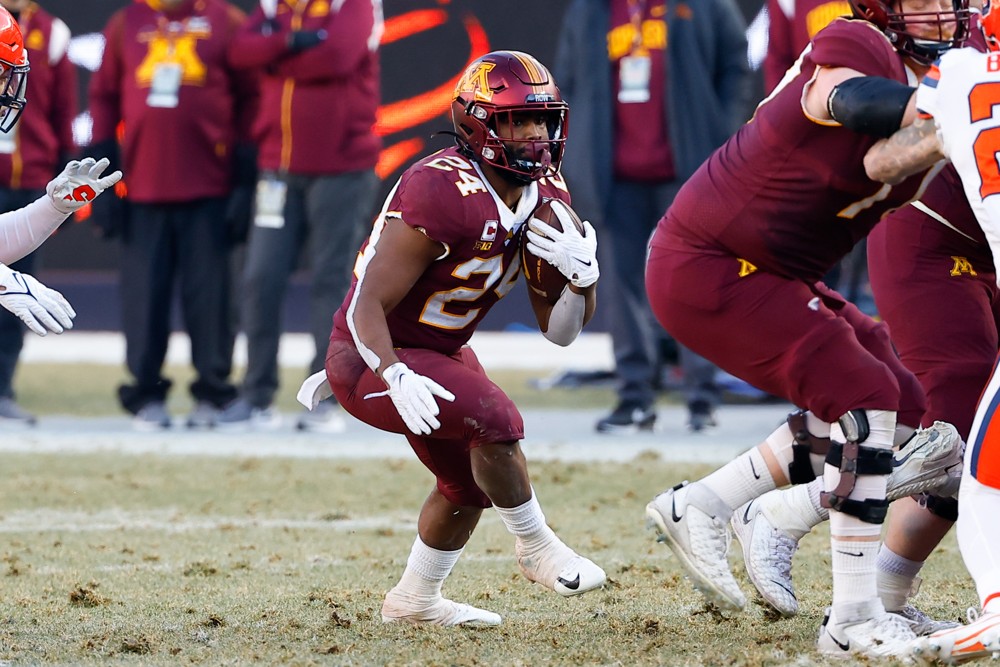A quarterback drops back to pass, gets tackled, and fumbles the ball. The average football fan calls this a sack, but depending on what happens to the ball after the fumble, it may not be.
Jalen Carter experienced this firsthand last year.
The official NCAA rulebook has two scenarios where this is not a sack, and in one case, not even a tackle for loss. From Section 16, Articles 8-9, including Clarification:
“A.R. 8. Adams is back to pass, but has the ball stripped from his grasp before his arm starts going forward by Benson, causing a fumble. The ball is then recovered behind the line of scrimmage by Allen, who attempts to gain positive yardage before being tackled by Baker, still behind the line of scrimmage. Credit Benson with a forced fumble only. Credit Baker with a solo tackle and a solo tackle for loss for the yards lost to the final spot. Charge Adams with a rush attempt and minus yards rushing to the final spot. Charge Team A with a fumble not lost. Allen is not credited with any statistics on this play.
A.R. 9. Adams is back to pass, but has the ball stripped from his grasp before his arm starts going forward by Benson, causing a fumble. The ball is then recovered behind the line of scrimmage by Allen, who gains positive yardage before being tackled by Baker beyond the line of scrimmage. Credit Benson with a forced fumble only. Credit Baker with a solo tackle. Charge Adams with a rush attempt for zero yards. Credit Allen with no rush but with the yards gained from the line of scrimmage under “Rushing.” Credit Team A with a fumble not lost.”
Clarification: For plays that end either on the line of scrimmage or beyond, there is no pass sack credited, but rather it is considered a rushing play. There can be no pass sack (or tackle for loss) without loss of yardage.
In Article 8, the QB drops back to pass, a defender forces a fumble, and an offensive player picks it up and tries to advance the ball. The offensive player tackled behind the line of scrimmage (LOS), and the defender doesn’t get credit for a sack. In Article 9, same scenario, but the fumbled ball is advanced past the LOS, and no sack is credited to the defender. The Clarification expands in a concise way by stating that a play that ends with a 0 or positive yard gain can’t be credited as a sack. The NFL would credit the defender with a sack in both of these scenarios, but not the NCAA.
The NCAA tries to assign every single yard in a game to a specific player, while the NFL allows for “phantom” yards to exist when a player shouldn’t be given credit. Example: Derrick Henry rushes for 5 yards, fumbles the ball 3 yards forward before a defender recovers it. Derrick Henry of Alabama would get 8 rushing yards because the ball is picked up 8 yards downfield, while Derrick Henry of the Titans would get 5 yards with the 3 yards the ball bounced assigned to nobody.
The fumble yardage rules come into play in almost every single game in college football (often multiple times), but how often do Articles 8 and 9 come into play? During the 2022 FBS season, 25 times. Below are a handful of examples of plays that are not officially sacks.
Clarification – The Colorado State QB fumbles the ball, and it goes 3 yards past the LOS. The QB actually gets +3 rushing yards on this play.
Clarification – The Utah State QB fumbles the ball, and it goes 1 yard past the LOS. The QB actually gets +1 rushing yard on this play.
Article 9 – The Tennessee QB fumbles the ball, and it is picked up by an offensive player who tries (and does) to advance it. The defender still gets a TFL, but not a sack.
Article 8 – The Tennessee QB fumbles the ball, and it is picked up by an offensive player who tries to advance it. The improper spotting of the ball (should’ve been a safety) means the player actually did advance the ball. The defender gets a TFL, but not a sack.
First off, I am in favor of every one of those plays being credited as sacks, but by the official NCAA rules, they are not. Secondly, the NCAA doesn’t count team-tracked statistics as official statistics so a play by play (PBP) on a team’s website crediting it as a sack, doesn’t mean it is a sack. College PBPs have errors in them (a truly painstaking process on our end to try to get things right) as they are done live, sometimes by inexperienced people, where mistakes are made. To make it even worse, college refs aren’t perfect and make mistakes as well (see the ball spotting error on the Jalen Carter non-sack), and once the refs place the ball, it is an official placement.
While this happened only 25 times last season, it is still noteworthy as sacks are such a crucial, and often-referenced stat to make a case for a player’s ability or, further down the road, a case for their team’s Ring of Honor or the Hall of Fame. It really comes down to common sense. When you watch those plays, they look like a sack and act like a sack, and they should be tracked as a sack.
There are other differences on sacks between the NCAA and NFL that are noteworthy. If the QB drops back to pass, scrambles, and is tackled for a 0-yard gain, the NCAA doesn’t credit that as a sack, since there isn’t a loss of yardage, while the NFL does credit a sack.
How many 0-yard scrambles could there be in college? During the 2022 FBS season, there were 328. If the ball is spotted behind the LOS in college, but not enough for a full-yard, it is credited as a 0-yard scramble, meaning a defender loses a sack by a matter of inches.
I am of the opinion that the NCAA should adapt those two rules and track those plays like the NFL, but there is one scenario that the NCAA tracks sacks better than the NFL, intentional grounding calls.
When a QB is called for intentional grounding, the ball is usually placed at the spot of the foul (minor exceptions occur), but in the NCAA, the defender who forces the QB to get rid of the ball (or closest defender to him) gets credit for a sack with a loss of yards to the spot of the foul coupled with a 0-yard penalty that results in a loss of down. The NFL doesn’t credit a defender with a sack, but instead assigns the yards as penalty yards.
This means that NFL QBs can short sack totals by simply getting rid of the ball at the last moment and taking the credit away from the defender. In the eyes of nearly every defensive coach, getting an intentional grounding call is essentially a sack as it moves the offense back the same yards and results in a loss of down. Defenders don’t receive the statistical credit in the NFL on these plays however and as stated early, stats such as sacks are often used to determine a player’s value down the line.
At the end of the day, neither league has a perfect stat-tracking system, and maybe to the average fan, they don’t care, but to the people who track these stats and to the players who obtain them, it matters. A few simple rule changes could greatly improve the way sacks are tracked and how a better description of what actually happened on a play. So for those of you that are wondering why we have Jalen Carter with one sack less than the “general consensus,” now you know why.


